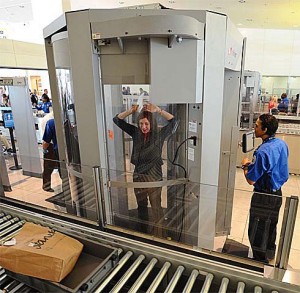
A passenger gets scanned in a body scanner.
Ah body scanners. One of my favorite topics to write about (or hate on). If you have missed out on previous posts let me re-cap why I don’t like them:
* They violate our privacy. Not just people seeing your almost-naked bodies, but those that might have a disability and really don’t want some TSA agent to see it.
* They can be avoided. All you have to do is say, “no,” and you can get a pat-down. Not even trying, I avoided the body scanner and a pat-down.
* I hate the, “what about the children,” argument, but do you want your child’s scans looked at by some stranger?
* They already have been, and I assure you will continue to be, abused.
* There is now talk that these scanners give you more radiation than once thought.
* They cost a lot and do nothing more than provide a false sense of security for passengers.
Now Senators Bob Bennett (R-UT) and Sen. Amy Klobuchar (D-MN) have introduced a bill to require all commercial airports to have and use body scanners by 2013. The bill is called the Securing Aircraft From Explosives Responsibly: Advanced Imaging Recognition Act. If that is too long for you, there is a fun acronym: S.A.F.E.R. A.I.R. Act. I wonder how much time they spent on the acronym versus seeing how this bill would really make passengers safer.
The Senators feel the Department of Homeland Security (DHS) has been spending too much time testing out the body scanners and need to get them installed ASAP nationwide. Currently the scanners are installed in only 48 airports across the US.
The bill requires that body images “cannot be stored, transferred, copied or printed,” and it forbids security personnel from having cameras near the machinery. Of course we all know that every TSA agent has followed all the rules already associated with the body scanners (that is sarcasm). I understand that most TSA employees take their job very seriously and do not abuse the system, but it only takes a few to make the whole agency look bad.
I have written a lot about these scanners and seem to have people just argue that they are better than nothing or if you don’t like them, don’t fly. I haven’t seen how the system is currently planned to be set up, how it makes us any safer. I would love to be proved wrong on this.
Thank you Chris Salman for point this out!
Source: RawStory.com Image: CRozeman
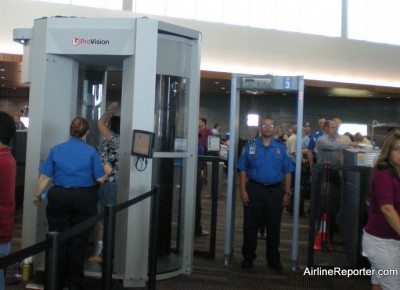
You can see a woman being scanned. The TSA agent who yelled at me is standing in the metal detector.
I have made my opinion on body scanners quite clear. If you have missed it, bottom line is I don’t like them. They violate our privacy and passengers are able to avoid them and request a pat-down, making them pointless.
On Sunday I flew from Tampa to Seattle via Denver and got my first view of the body scanners in action at Tampa International Airport. The scanner is not too imposing, but it is obviously something different. There are a few body images by the scanner that show you what it does, but they are small and people are rushed by them.
The whole time I was waiting in the security line, the body scanner wasn’t being used. By the time I was taking off my shoes, they had started pushing passengers into the scanner versus the metal detector.
I started to get excited. Not to try it out, but to respectfully decline going through the body scanner and get a pat-down instead. Well maybe excited is not the right word. The thought of having some stranger feel around my body isn’t great, but I wanted to take a little stand against the privacy invading machines.
I was flying with my girlfriend, Amy, and even though she knew about the scanners (or had heard me rant about them from time to time), she really didn’t understand my true dislike of them. The two people before us were told to go in the scanners. Then I was next, but I started going to the metal detector instead. I was waiting to be told I had to do the scanner or pulled aside to get a pat-down, but I was not. I just walked through the metal detector while the people in front of me and behind me were all forced into the body scanner. Now that is a big hole in security.
From what I have read, a passenger who does not do the body scanner, must be patted down. However it seemed unorganized and I don’t think the TSA agent at the metal detector realized people were being pushed into the body scanner.
Amy wasn’t so lucky. She felt rushed and not really sure what was going on and didn’t decline being scanned. They made sure she had no foreign items on her, she had to raise her hands and the scanner went around her and then she had to stand outside of the scanner with a TSA agent holding her in a roped off area (everyone had to do this). He was waiting for someone in another area to view her body images and confirm she was clean. He was talking to them via radio, but they didn’t seem to be working. It took about a minute for him to get a response that the two females could go (Amy was one of them). I trust it was a radio error and those images weren’t on the screen any longer than they needed to be.
After I was done and Amy was waiting to hear she was clear to go, I was taking some photos of her and the scanner. This is when the TSA sprung into action. From the metal detector I heard, “sir, you cannot do that.” I confirmed he was talking to me and that I wasn’t allowed to take photos of the body scanner. I am not exactly sure if there are rules against taking photos. I guess someone might take photos and learn how to beat the system? Well I don’t need to take photos to see how the system doesn’t really work, you just had to ask for a pat-down or in my case, just go through the metal detector. They never came over to take my photos or talk to me, so obviously it couldn’t have been that big of a deal to them.
What doesn’t make sense is they took action against me for taking photos, but no one noticed I didn’t go through the body scanner nor get a pat-down. It is so inconsistent. By no means was I trying to do this on purpose, but I imagine similar experiences are happening like this all around the world.
I know I talk negatively about these scanners, but I feel there is some hope in the near future. There are body scanners with Automated Target Recognition that have the ability where no human actually sees your image. The computer looks at your body scan and if there are any foreign items, it will flag you and the TSA will inspect you. There is a display of a stick figure only. If they had this version, which didn’t violate privacy, and it was required, not optional, I could get behind the body scanners. But until then, I will continue to voice my strong opinion against them and about the inconsistencies of their usage. However, the TSA says there is no system they feel meets their security needs yet.
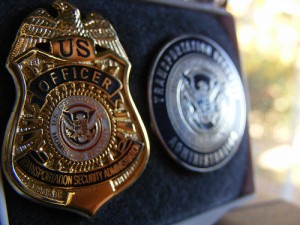
TSA badge
Fort Wayne International Airport is the latest airport to get the full-body scanners, which brings the total US airports to 23. I have not hidden my opinion that full-body scanners are a bad choice due to the fact that they violate a passenger’s privacy and can be easily avoided.
Last week a Transportation Security Administration (TSA) worker at Miami International Airport ended up being arrested, after a co-worker teased him about his genitals.
Rolando Negrin was being scanned as a training exercise when a co-worker started to repeatedly harass him for the size of his “manhood.” Witnesses say Negrin lost it and started to hit his co-worker with a police baton. Negrin could be heard saying in Spanish, “get on your knees or I will kill you and you better apoligise [sic].”
The TSA has a zero-violence policy and stated, “we are investigating to determine whether other officers may have violated procedures in a training session with coworkers and committed professional misconduct.”
The TSA likes to note that this incident was internal and did not involve the general public. However, we have already seen the body scanners abused in public once and as they are used more, I am sure we will see them abused again.
When scanning passengers, the TSA says that a screener views the live image in a remote location and the images will be permanently deleted, never being stored. However, in a letter to the Electronic Privacy Information Center (EPIC), the TSA states they have 2,000 test images stored, using TSA personal, at its test facility. This means that the system has the capability to store images, not to mention workers could sneak in cameras or phones.
EPIC has tried to gain access to the test images to see how privacy might be violated, but the TSA has refused to release them. EPIC has filed a lawsuit against the Department of Homeland Security under the Freedom of Information Act seeking details about the government’s use of advanced imaging technology. Many fear if the scans are publicly released, it will allow people to learn how to beat the system. Right now the system is really easy to beat, just refuse to be scanned and ask for a pat-down.
How much is all this wonderful security costing you, the tax payers? Only $6Billion per year. According to Stanford Daily, when airport security was still privatized in 2001, it only cost $700Million. Even in comparing with 2001 prices, that is $700million versus $4.6Billion.
It is frustrating to see stories like this continue to pop-up. I am sure this will not be the last story of a passenger’s rights being violated. Stay tuned…
Image: Tektum
connect | web | twitter | facebook |
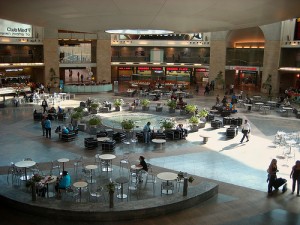
Ben Gurion International Airport outside of Tel Aviv.
A few weeks ago I wrote a blog calling body scanners a “joke” and I was quite harsh on the Transportation Security Administration’s (TSA) decision to move forward with them.
Don’t get me wrong. I fly a lot. I like my life. I am all about protecting it and those who fly with me. But, I am not about the TSA wasting money for “security theater.”
After I posted my thoughts, the TSA posted a blog titled, “Advanced Imaging Technology – Yes, It’s Worth It.” It seem to be a rebuttal to those of us who have voiced concern about the TSA moving forward with the body scanners. However, TSA’s explanation is short on actual specifics of how the body scanners will stop someone from doing harm to airlines and passengers.
In my previous blog, my biggest issue was people could choose to avoid the scanners. If you didn’t want to be scanned, you could opt to get a pat down. For privacy reasons, it is great they offer this alternative, but for safety reasons it makes no sense. Why use all this pricey equipment, if someone who wants to do harm can just avoid it?
Their blog does a wonderful job explaining how these high-tech body scanners can pick up the smallest illegal items, but nothing about how scanners can be avoided or steps that are being taken to stop more privacy violations. I posted the question directly to the folks at TSA Blog, but never got a response, even though they did answer other people’s questions.
Over on my Seattle PI syndication I currently have 45 comments from readers who feel strongly (on both sides) about the body scanners. This shows me there are quite a few other people out there that have grave concerns about these scanners. I have been told a few times, “okay smart guy, how about stop just complaining and provide a solution” (okay, maybe not exactly like that, but you get the idea).
I would really hope someone out there with experience in air safety, could find a better solution. Talking to people about airport security I kept being told to check out out how Israel works their airport and airline security. So, I did and what I found looks like they might be on to something.
Isreal’s security allows for greater security, but less inconvience for travellers. And it must work. Tel Aviv’s Ben Gurion Airport, Israel’s larget hub, has not had a security breach since 2002.
“It is mindboggling for us Israelis to look at what happens in North America, because we went through this 50 years ago,” said Rafi Sela, the president of AR Challenges, a global transportation security consultancy, in an interview with TheStar.com. He’s worked with the RCMP, the U.S. Navy Seals and airports around the world. “Israelis, unlike Canadians and Americans, don’t take shit from anybody. When the security agency in Israel (the ISA) started to tighten security and we had to wait in line for not for hours but 30 or 40 minutes, all hell broke loose here. We said, ‘We’re not going to do this. You’re going to find a way that will take care of security without touching the efficiency of the airport.”
Their security is a multi-layer system:
LAYER 0: Intelligence
Before anyone even leaves for the airport, Isreal has strong intelligence network, trying to determine particular threats and dispose of them before they even reach the first layer.
LAYER 1: Roadside Check
Before you can even get to the airport, security stops every car and asks two questions, “How are you? Where are you coming from?” The answers aren’t nearly important, but more of how the person responds. Security officers are trained to detect nervousness and distress. Not the amount that a lot of people feel from flying, but those that occur when you are about ready to kill yourself and many others.
LAYER 2: Outside Guards
Armed guards are stationed outside the terminal and are trained to observe passengers. Any sort of odd behavior or strange baggage, you will be pulled aside for additional questioning and possible searches.
LAYER 3: Bag Inspections
Passengers that look suspicious or are just random will be pulled aside to be scanned by a metal detector and have their bags scanned.
LAYER 4: Ticket Agent Questions
Now, you have fully made it into the terminal. The ticket agent will take your documents and ask you a series of questions, the whole time, looking directly into your eyes, “which is very embarrassing. But this is one of the ways they figure out if you are suspicious or not. It takes 20, 25 seconds,” said Sela. Again, they are specially trained to detect body language that would show the person means to do harm. Also, passengers are not allowed to group up, which would provide a group target for a terrorist.
LAYER 5: Bag Termination
Let’s say a terrorist has made it through the first four layers of security and still is able to get his bomb to the ticket agent. Every bag is screened right away. If a bomb or suspicious material is found, they do not evacuate the whole terminal, like you would see in America. Evacuation causes panic, more targets, and a huge delay. Instead, scanners have bomb boxes near by and a suspected bag is put into the box, which can contain an explosion of up to 100 kilos of plastic explosives. People within a few meters of the suspected bomb need to be cleared and the rest of the airport is able to go through its normal business. “This is a very small simple example of how we can simply stop a problem that would cripple one of your airports,” Sela said.
LAYER 6: Body and Luggage Check
You would think this is like America’s security check, but Sela says, “Here it is done completely, absolutely 180 degrees differently than it is done in North America. First, it’s fast there’s almost no line. That’s because they’re not looking for liquids, they’re not looking at your shoes. They’re not looking for everything they look for in North America. They just look at you.”
All these layers have solid security, but they also get passengers from the parking lot to their gate in less than 25 minutes. Now, that is impressive. Sela feels the TSA could move in this direction, but they are on the wrong path. “Even today with the heightened security in North America, they will check your items to death. But they will never look at you, at how you behave. They will never look into your eyes … and that’s how you figure out the bad guys from the good guys.”
Yes, this is profiling, but I think it is the good kind of profiling. Racial profiling = wrong, behavior profiling = right. Sela said, “To us, it doesn’t matter if he’s black, white, young or old. It’s just his behaviour. So what kind of privacy am I really stepping on when I’m doing this?”
Do the Israelis have a good security system? I think so, but I don’t think it could easily be used the exact same way in America. We definitely don’t do well with seeing people with large guns walking around and this system would be vulnerable to racial profiling. I do think looking at behavior profiling would be a better use of resources than spending money on machines that people can skip all together.
Sources: TheStar.com & Vancouver Sun Image: iamxande
connect | web | twitter | facebook |
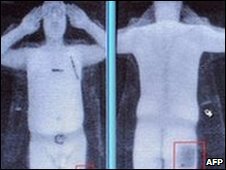
Image from a body scan
From the beginning I have been against airport body scanners. Not only because of the privacy aspect, but they just don’t work effectively. I have been watching closely the development of the body scanners, which are starting to be used around the world, and problems are already popping up.
Probably the biggest issue is that the body scanners can easily be avoided. Stephen Frischling recently looked how even the very best security is no good, if someone wanting to do harm can just circumvent it.
Kathleen Petrowsky, the Transportation Security Administration’s (TSA) Director at Chicago O’Hare Airport, first stated it would be mandatory for all passengers to be scanned with the body scanners. However, after making that statement, Frishling received a reply from the TSA’s blog team stating, “Imaging technology is optional. No plans to make it mandatory’¦ Anything else you read is incorrect.” Frischling confirmed this with the TSA’s Public Affairs unit that the scanners would be optional. Passengers who do not want to be scanned would be able to have a pat down instead.
Hmm. We are told that pat downs are not affective enough at stopping terrorists; so we need the body scanners, yet they are not required? What would stop someone who wanted to do harm to request a pat down? Not to get too graphic but there are a lot of places someone could hide something they don’t want found. At about $150,000.00 a pop is this really a good investment?
Does this mean I am advocating the body scanners be required? No way! Putting the fact you can avoid them aside, there is still the issue of privacy. JetBlue’s BlueTales blog recently reported about a security agent who made a sexually charged remark about a passenger who accidentally walked through a body scanner at London Heathrow Airport. He stated, “love those gigantic ****” (click here for the actual wording) when the 29 year old female passenger walked through.
The machines are designed well and they do a good job. The weak part are the people. Don’t get me wrong, the majority of TSA workers are great workers and do a wonderful job. But you only need a few people to screw up a whole process. Yes, in America the TSA will be in a remote location reviewing the scanner images so passengers won’t have to hear if they make any inappropriate comments.
I really think it has to do more with security theater than anything else. It costs a lot of money, we are already seeing the privacy issues and it can be avoided all together, so what is the point? If passengers don’t feel safe, they won’t fly. These machines make most passengers feel safe even though in reality they aren’t any safer. Is it more important to spend money on safety you can see or safety that works?
Image: BBC
connect | web | twitter | facebook |




